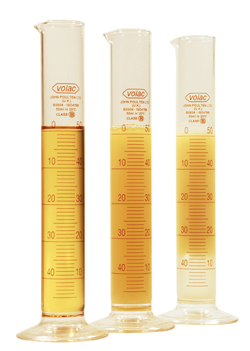Obtaining accurate and reliable fluid cleanliness data quickly in order to detect abnormal contamination is a key factor in ensuring the efficiency of industrial processes and reducing downtime.
There are five traditional methods for taking fluid samples. Method 1 is the best choice followed by Method 2 and Method 3. Method 4 should only be used if there is no opportunity to take a line sample, and Method 5 should only be used if all others are impracticable. DO NOT obtain a sample from a reservoir drain valve. Always take the sample under the cleanest possible conditions, and use pre-cleaned sample bottles.
Method 1: On-line Analysis
This procedure is for portable instruments that have to be connected to the system
- Check that the sampling position satisfies the reason for sampling and the sampling is done via a small ball valve with PTFE or similar seats, or a test point.
- Check that there is sufficient supply pressure to avoid instrument starvation or cavitation.
- Operate the system for at least 30 min.
- Remove any covers, caps etc from the sampling position and, if practical. clean the exterior of the connection point with a clean solvent.
- Carefully connect the instrument to the sampling point and minimise the generation of dirt.
- Operate the instrument in accordance with the manufacturer’s instructions and flush the sampling lines and instrument with a suitable volume of fluid, as specified by the instrument manufacturer. If not a volume equivalent to 10 times the volume of the connection pipes and instrument is appropriate.
- The analysis shall be continued until the data from successive samples is either:
a) within the limits set by the instrument manufacturer; or
b)the difference is less than 10 % at the minimum particle size being monitored if the required output is particle count; or
c) the same cleanliness code has been recorded.
Method 2: Small ball valve with PTFE or similar seats, or a test point
- Operate the system for at least 30 minutes prior to taking sample in order to distribute the particulate evenly.
- Open the sampling valve and flush at least 1 litre of fluid through the valve. Do not close the valve after flushing.
- When opening the sample bottle, be extremely careful not to contaminate it.
- Half fill the bottle with system fluid, use this to rinse the inner surfaces and then discard.
- Repeat step 4 a second time without closing the valve.
- Collect sufficient fluid to fill 3/4 of bottle (to allow contents to be redistributed).
- Cap the sample immediately and then close the sample valve. Caution: Do not touch the valve while taking the sample.
- Label the sample bottle with system details and enclose in a suitable container for transport.
Method 3: Valve of unknown contamination shedding capabilities
- Operate the system for at least 30 minutes prior to taking sample in order to distribute particulate evenly.
- Open the sampling valve and flush at least 3 to 4 Litres of fluid through the valve. (This is best accomplished by connecting the outlet of the valve back to the reservoir by using flexible tubing). Do not close the valve.
- Having flushed the valve, remove the flexible tubing from the valve with the valve still open and fluid flowing. Remove the cap of the sample bottle and collect sample according to instructions 4 to 6 of Method 2.
- Cap the sample immediately and then close the sample valve. Caution: Do not touch the valve while taking the sample.
- Label the sample bottle with system details and enclose in a suitable container for transport.
Method 4: Sampling from Reservoirs and Bulk Containers
Applicable only if Methods 1, 2, and 3 cannot be used
- Operate the system for at least 30 minutes prior to taking sample in order to distribute the particles evenly.
- Clean the area of entry to the reservoir where sample will be obtained.
- Flush the hose of the vacuum sampling device with filtered (0.8 µm) solvent to remove contamination that may be present.
- Attach a suitable sample bottle to the sampling device, carefully insert the hose into the reservoir so that it is mid-way into the fluid. Take care not to scrape the hose against the sides of the tank or baffles within the tank as contamination may be sucked into the hose.
- Pull the plunger on the body of the sampling device to produce vacuum and half fill the bottle.
- Unscrew bottle slightly to release vacuum, allowing hose to drain.
- Flush the bottle by repeating steps 4 to 6 two or three times.
- Collect sufficient fluid to 3/4 fill the sample bottle, release the vacuum and unscrew the sample bottle. Immediately recap and label the sample bottle.
Method 5: Bottle Dipping
Least preferred method
- Operate the system for at least 30 minutes prior to taking sample in order to distribute particulate evenly.
- Clean the area of entry to the reservoir where sample will be obtained.
- Ensure the outside of the bottle is clean by flushing with filtered solvent.
- Remove cap from the sample bottle. Carefully fill the sample bottle by dipping it into the reservoir and then discard the fluid after rinsing the inside of the sample bottle.
- Repeat step 4. Carefully fill the sample bottle, cap immediately and wipe the outside.
- Secure any openings in the reservoir.
Note: Incorrect sampling procedures will adversely effect the cleanliness level in the sample bottle. It is impossible to make a sample cleaner than the actual system but very easy to make it dirtier.
